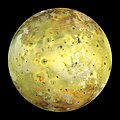Datei:Io highest resolution true color.jpg

Größe dieser Vorschau: 600 × 600 Pixel. Weitere Auflösungen: 240 × 240 Pixel | 480 × 480 Pixel | 768 × 768 Pixel | 1.024 × 1.024 Pixel | 2.048 × 2.048 Pixel | 3.196 × 3.196 Pixel
Originaldatei (3.196 × 3.196 Pixel, Dateigröße: 1,88 MB, MIME-Typ: image/jpeg)
Dateiversionen
Klicke auf einen Zeitpunkt, um diese Version zu laden.
| Version vom | Vorschaubild | Maße | Benutzer | Kommentar | |
|---|---|---|---|---|---|
| aktuell | 08:00, 21. Aug. 2018 |  | 3.196 × 3.196 (1,88 MB) | The NMI User | Reverted to version as of 23:57, 14 July 2018 (UTC): Needs margins from Kaldari because the crops are too close on all sides in this photo. |
| 22:08, 20. Aug. 2018 |  | 2.796 × 2.796 (1,81 MB) | Jdx | Reverted to version as of 18:51, 9 May 2010 (UTC) | |
| 03:55, 6. Aug. 2018 |  | 3.196 × 3.196 (1,88 MB) | Jcpag2010 | Reverted to version as of 23:57, 14 July 2018 (UTC) | |
| 07:40, 2. Aug. 2018 |  | 2.796 × 2.796 (1,81 MB) | PlanetUser | Reverted to version as of 18:51, 9 May 2010 (UTC) | |
| 01:57, 15. Jul. 2018 |  | 3.196 × 3.196 (1,88 MB) | Kaldari | margins | |
| 02:42, 21. Dez. 2015 |  | 2.796 × 2.796 (1,81 MB) | PlanetUser | Reverted to version as of 18:51, 9 May 2010 (UTC) | |
| 21:09, 23. Okt. 2015 |  | 2.952 × 2.940 (1,8 MB) | Jacek Halicki | frame | |
| 20:51, 9. Mai 2010 |  | 2.796 × 2.796 (1,81 MB) | Julia W | sorry, trying that again | |
| 20:35, 9. Mai 2010 |  | 2.796 × 2.796 (5,2 MB) | Julia W | fresh conversion to jpeg from tiff, at higher quality | |
| 21:39, 23. Apr. 2006 |  | 2.796 × 2.796 (771 KB) | Uwe W. | Original Caption Released with Image: NASA's Galileo spacecraft acquired its highest resolution images of Jupiter's moon Io on 3 July 1999 during its closest pass to Io since orbit insertion in late 1995. This color mosaic uses the near-infrared, gr |
Dateiverwendung
Die folgenden 17 Seiten verwenden diese Datei:
- Gezeitenheizung
- Io (Mond)
- Liste der Entdeckungen der Planeten und ihrer Monde
- Liste der besuchten Körper des Sonnensystems
- Liste der größten Objekte im Sonnensystem
- Orte im Star-Trek-Universum
- Benutzer:Augiasstallputzer/Testeite
- Benutzer:BullBoxerBAB/Himmelskörper im Sonnensystem
- Benutzer:LDV-Physik
- Benutzer:LDV-Physik7
- Benutzer:Simplicius/Archiv/Himmelskörper
- Wikipedia:Café/Archiv 2014 Q1
- Wikipedia:Kartenwerkstatt/Blog/2
- Portal:Astronomie/Exzellente Artikel
- Portal:Raumfahrt/Bild des Tages/30. November
- Portal:Raumfahrt/Bild des Tages/4. Quartal
- Portal:Vulkane/Artikelgalerie
Globale Dateiverwendung
Die nachfolgenden anderen Wikis verwenden diese Datei:
- Verwendung auf af.wikipedia.org
- Verwendung auf als.wikipedia.org
- Verwendung auf an.wikipedia.org
- Verwendung auf ar.wikipedia.org
- كبريت
- بلوتو
- بوابة:علم الفلك/تصنيفات
- بوابة:المجموعة الشمسية
- أقمار المشتري
- أقمار غاليليو
- آيو (قمر)
- قالب:المجموعة الشمسية
- قائمة أجرام المجموعة الشمسية مرتبة حسب الحجم
- قائمة أجرام النظام الشمسي المستديرة بالجاذبية
- قائمة الأقمار الطبيعية
- خط زمني لاكتشاف كواكب المجموعة الشمسية وأقمارها
- اكتشاف واستكشاف النظام الشمسي
- قائمة أنواع الكواكب
- بوابة:المجموعة الشمسية/هل تعلم/2
- مستخدم:ASammour/صور مختارة في الفارسية والتركية
- 1981 ميداس
- مرصد براكين آيو
- Verwendung auf ary.wikipedia.org
- Verwendung auf arz.wikipedia.org
- Verwendung auf ast.wikipedia.org
- Verwendung auf azb.wikipedia.org
- Verwendung auf az.wikipedia.org
- Verwendung auf ba.wikipedia.org
- Verwendung auf be-tarask.wikipedia.org
- Verwendung auf be.wikipedia.org
- Verwendung auf bg.wikipedia.org
- Verwendung auf bh.wikipedia.org
- Verwendung auf bn.wikipedia.org
Weitere globale Verwendungen dieser Datei anschauen.





